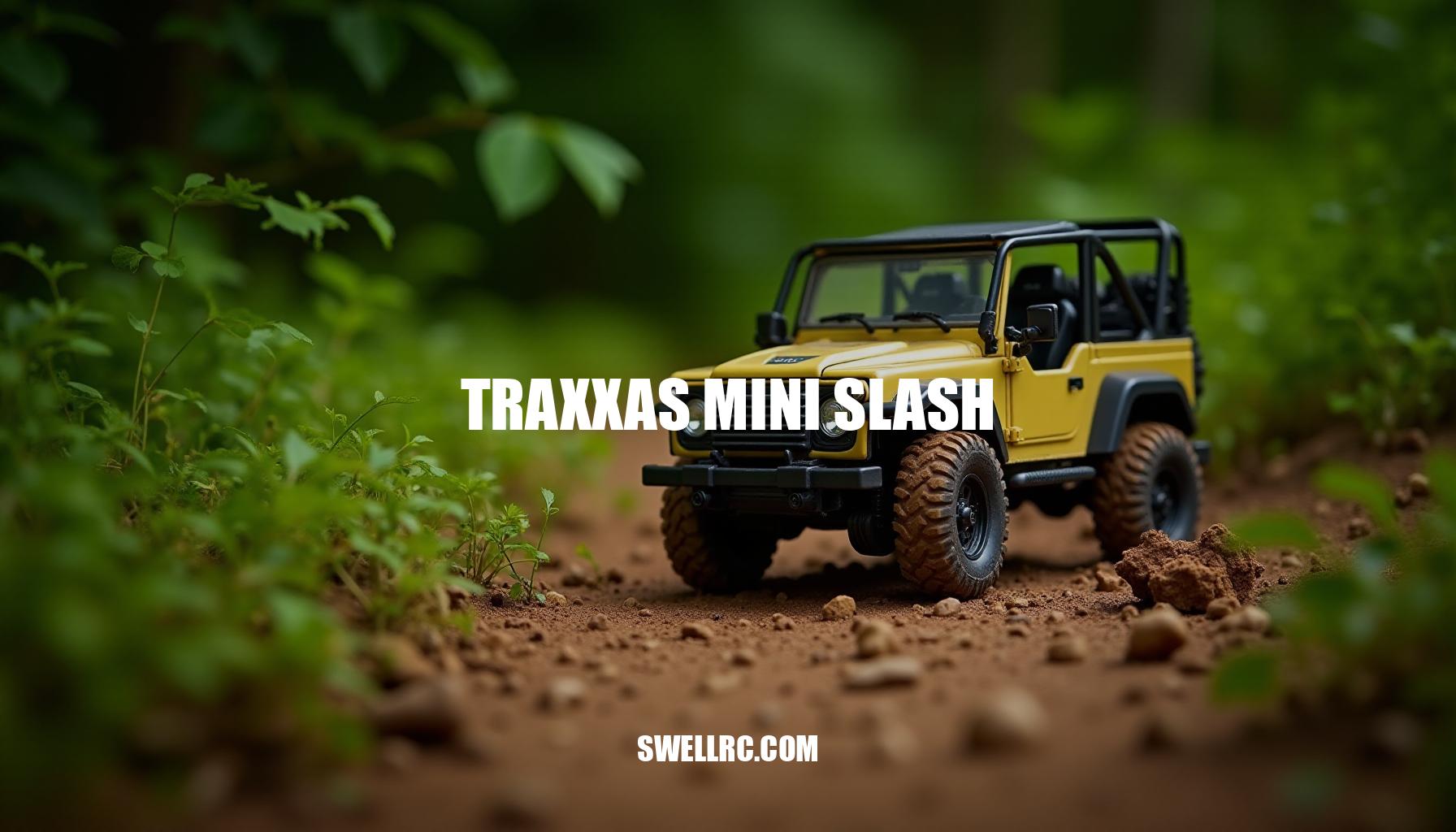Traxxas Mini Slash Review: Compact Power, Endless Fun
I recently rediscovered the Traxxas Mini Slash after a weekend shakedown session cycling through half a dozen Traxxas RC trucks. Initially, I anticipated a fun 1/16 short-course truck, but what surprised me was the punch, exceptional grip, and outstanding trail manners it delivered. Borrowing the DNA of the renowned Traxxas Slash lineup—with its short-course stance, rugged bumpers, and that planted feel—the Mini Slash compresses these features into a compact 1/16 package.
This compact RC truck is not only easy to toss in a backpack but is also tough enough for everyday use, proving that being mini in size doesn’t mean skimping on attitude.
For enthusiasts curious about how it stacks up against its full-size counterpart, the Mini Slash retains the spirit and a surprising chunk of the speed, without the bulk. When considering the power-to-size ratio, the Mini Slash impresses by delivering thrilling performance reminiscent of the larger Slash. In fact, I often benchmark these trucks against the bigger models—if you want context on how fast a Slash 2WD can go, check out this detailed review: Traxxas Slash 2WD Speed Insights.
This hobbyist review combines lab-style testing and extensive dirt time to help you decide if the Mini Slash should be your first RC, your next upgrade, or your secret weapon for RC off-road racing.
Whether you’re a seasoned racer or new to remote control short course trucks, the Mini Slash brings a unique blend of portability, durability, and high-octane fun.
Design & Build: Compact Size, Big Personality
The Mini Slash is a prime example of 1/16 scale RC trucks designed with durability engineering at its forefront. It features a low, wide short-course body equipped with energy-absorbing bumpers both front and rear, complemented by high-clearance fenders and reinforced shock towers that easily withstand the abuse from cartwheels and rough impacts. The chassis material is a rugged composite nylon tub with integrated skid plates, providing a strong foundation while maintaining a lightweight profile.
What sets the Mini Slash apart is its sealed drivetrain and water-resistant electronics, including a receiver box, ESC, and servo, all strategically positioned low within the chassis to enhance stability and keep the center of gravity tight. The truck’s oil-filled, adjustable shocks allow for fine-tuning suspension dynamics, which is vital when tackling jumps or quick directional changes. Unlike trail-ready platforms like the Traxxas Jeep style builds, the Mini Slash emphasizes nimble handling and neutral jumping rather than slow-crawl finesse.
After extensive testing on rough park trails and hardpack surfaces, the balance and predictability of the Mini Slash stand out—it stays composed even when you overcook a corner and lands flat after jumps, a testament to its thoughtful design and quality build components.
| Specification | Details |
|---|---|
| Scale | 1/16 |
| Drivetrain | Shaft-driven 4WD (on most variants) |
| Chassis Material | Composite nylon |
| Shock Type | Oil-filled, adjustable |
| Tire Type | Short-course tread |
| Battery Bay Dimensions | Fits 1/16 NiMH stick or compact 2S LiPo |
| Waterproof Electronics | Receiver box, ESC, servo included |
| Approximate Ground Clearance / Wheelbase | Varies by model, optimized for quick handling and stability |
Performance Breakdown: Speed, Handling, and Control
Stock, the Mini Slash is lively and confidence-building. Equipped with a brushed motor RC system powered by a fresh NiMH pack, you can expect fun-park speeds and brisk acceleration that excite newcomers and veterans alike. Jump to a brushless setup coupled with a quality 2S LiPo battery setup, and the truck truly wakes up — offering faster throttle response, stronger torque off the line, and improved top-end performance.
In my own experiments swapping between 2S and carefully geared 3S LiPo packs, I noticed a major jump in response and power output; however, I recommend sticking with 2S for most drivers to keep ESC performance and motor temps in check and to reduce wear. Proper gearing ratio adjustments make a meaningful difference: a tooth or two taller pinion gear adds top speed but increases heat generation, so always monitor motor and ESC heat during runs.
Tuning the Mini Slash for optimal handling is straightforward:
- Using one step heavier shock oil calms chassis pitch on landings for smoother control.
- Lowering ride height slightly trims traction roll on grippy asphalt surfaces.
- Waterproof electronics ensure reliable performance in real-world conditions — puddles and wet grass won’t faze the truck, though it’s wise to dry bearings afterward to maintain longevity.
If you are considering full brushless conversions or aiming to chase category leaders, you might want to skim broader picks and principles here for guidance.
| Setup | Approximate Speed (mph) | Notes |
|---|---|---|
| Brushed Motor + NiMH | Mid-teens to low-20s | Good beginner setup, fun accelerations |
| Brushless Motor + 2S LiPo | Upper-20s to mid-30s | Better throttle response and torque, recommended for most |
| Brushless Motor + 3S LiPo | Top-end high 30s+ | Major jump in power, requires careful tuning and monitoring |
Customization & Upgrades: Unlocking More Power
I couldn’t resist pushing it beyond factory specs with key customization steps that yield significant performance gains. Easy wins include:
- Swapping to a quality 2S LiPo battery for improved power delivery
- Installing a steel spur gear and hardened pinion to handle increased torque
- Dropping in high-grip short-course tires tailored to your surface for enhanced traction
- Adding aluminum shock caps to boost shock absorption and longevity
To truly unlock speed, a sensored 1/16–1/10 light-duty brushless system paired with proper gearing transforms both punch and throttle finesse. For robust durability, consider driveline upgrades such as metal CVDs, aluminum steering bellcranks, and a reinforced servo saver that withstand aggressive driving.
Looking for more control? Programming punch/brake curves in the ESC and utilizing thicker diff fluid up front enhances stability during high-speed maneuvers, complementing your refined suspension tuning.
Aesthetics play a vital role in personalization—custom wraps and graphics translate beautifully from other Traxxas lines, offering deep dive styling inspiration like this wrap guide. For enthusiasts curious about drivetrain changes, particularly on the Mini Slash platform which is typically 4WD, exploring 2WD-to-4WD conversions on larger models provides valuable background on complexity and components involved; see this resource for detailed insights.
Bottom line on return on investment (ROI): upgrading batteries, tires, and gearing delivers the biggest bang for your buck in terms of performance, while alloy components—though often labeled as “bling”—are primarily about achieving precision feel and extending part lifespan rather than outright speed.
Versus: Mini Slash Compared to Other RC Icons
When considering the Mini Slash vs Slash 2WD, the Mini Slash offers a unique blend of portability and agility at the expense of the full-size Slash’s absolute stability and extended track-length stride. Its compact size makes it easier to store and less intimidating in tight spaces, while also reducing running costs through cheaper tires and batteries. This makes the Mini Slash exceptionally well-suited for enthusiasts who prioritize convenience without sacrificing too much performance.
In the Traxxas Maxx comparison, the differences become even more pronounced. The Mini Slash is lighter and far more manageable indoors, ideal for those seeking a nimble, bag-and-go RC experience. In contrast, the Maxx is a powerhouse designed for big-air antics and features massive suspension travel, truly built for rugged outdoor terrains.
For a clearer perspective on the Maxx’s impressive size and capabilities, visiting resources like how big is the Traxxas Maxx? can be insightful.
Looking beyond these models to specialized behemoths such as the Raminator RC Car reveals a focus on spectacle and scale rather than compact agility, underscoring the diversity within the RC ecosystem. For potential buyers on a budget, it’s worth noting that authentic Traxxas experiences under $100 are uncommon, but understanding the price perspective through guides like Traxxas RC cars under $100 helps set realistic expectations for entry-level shoppers.
Moreover, when comparing electric vs gas RC models, each brings distinct advantages and trade-offs. Electric RC cars like the Mini Slash offer cleaner operation, easier maintenance, and enhanced portability, while gas-powered models provide longer run times and an authentic fueling experience. For an in-depth primer on these differences, check out Traxxas gas-powered RC cars.
Bottom line: The Mini Slash comfortably occupies a sweet spot within the RC world—delivering short-course handling combined with genuine 4WD grip and the convenience of pack-and-play portability, making it an excellent choice for hobbyists valuing both performance and practicality.
Real-World Ownership Experience & Maintenance Tips
Durability is classic Traxxas: bumpers save the front, skid plates protect the belly, and parts are widely available, ensuring long-lasting performance. To keep your Mini Slash feeling box-fresh longer, incorporating some simple maintenance habits is key. These include:
- After wet runs: Blow out water thoroughly, spin-dry the drivetrain to prevent rust, and add a drop of bearing oil to keep bearings running smoothly—essential steps in waterproof care.
- Regular checks: Every few packs, inspect the pinion mesh and slipper clutch tension.
Heat cycles can loosen hardware, so troubleshooting these components prolongs durability.
- Shock maintenance: Wipe down shocks and look for weeping seals. When damping fades, top up the shock oil to maintain optimal performance.
- Spare parts readiness: Always keep a spare spur gear, body clips, and front hubs in your pit bag. These inexpensive parts can turn a bad tumble into a quick five-minute fix.
- Battery storage: Store LiPo batteries at storage voltage and keep NiMH packs cool and dry to extend pack lifespan.
If you run mixed fleets, you’ll find that cross-model accessory handling—like boat hardware installation or transmitter pairing—often follows similar maintenance and troubleshooting routines across Traxxas lines.
For example, visit this water-side accessory guide to see the accessory/parts mentality in action.
Following these basics helps ensure your Mini Slash remains a reliable rig you can confidently hand over to friends without stress.
Conclusion: Why the Mini Slash Still Feels Legendary
After all the testing, racing, and inevitable rollovers, this little truck earned my lifelong respect. The Traxxas Mini Slash perfectly captures the essence of RC culture by combining compact power with accessibility and versatility. Its design invites newcomers to embrace the thrill of RC while offering seasoned enthusiasts the depth to customize — tweaking springs, gearing, and throttle curves to their liking.
In a hobby known for extremes—from giant monsters to blazing boats—the Mini Slash stands out by proving that portability and performance can absolutely coexist. Here’s what makes this truck a must-have:
- Compact Power: Packs a punch in a small frame, delivering impressive speed and agility.
- Accessibility: User-friendly for beginners but with plenty of tuning options for veterans.
- Versatility: Perfect for various terrains, turning any patch of dirt into a proper short course excitement stage.
- Hobby Enthusiasm: Combines fun and challenge, keeping passion for RC alive.
Pair the Mini Slash with your bigger Traxxas favorites to create a full-garage experience, or simply keep it as the go-fast truck you actually bring everywhere. No matter how you choose, this truck is a true celebration of hobby enthusiasm and the vibrant RC culture.
Frequently Asked Questions
- What scale is the Traxxas Mini Slash?
It’s a 1/16-scale short-course truck, essentially a scaled-down Slash with real short-course proportions and 4WD on most variants. - How fast does a Traxxas Mini Slash go with a stock setup?
Expect roughly mid-teens to low-20s mph with a brushed motor on a healthy NiMH pack, and upper-20s to mid-30s mph with a brushless system on a good 2S LiPo. Exact speed depends on gearing, surface, battery condition, elevation, and temperature. - Is the Traxxas Mini Slash good for beginners?
Yes. It’s durable, compact, and features water-resistant/“waterproof” electronics. Traxxas ESCs also offer a Training Mode to reduce power while you learn, making it a friendly first short-course truck that still has room to grow. - What’s the difference between a Traxxas Mini Slash and a Traxxas Slash 2WD?
The Mini Slash is 1/16 scale, typically 4WD, and designed for agility and portability. The Slash 2WD is 1/10 scale, rear-wheel drive, more stable at high speeds, and better for full-size track layouts. The bigger truck carries larger batteries/tires and costs more to run, while the Mini is easier to store and transport. - Can you upgrade the Mini Slash for more speed or durability?
Absolutely. Common upgrades include a brushless motor/ESC with proper gearing, 2S LiPo packs, high-grip tires, aluminum shock caps, metal CVDs, reinforced steering parts, and thicker diff fluids. These mods boost acceleration, control, and longevity.



